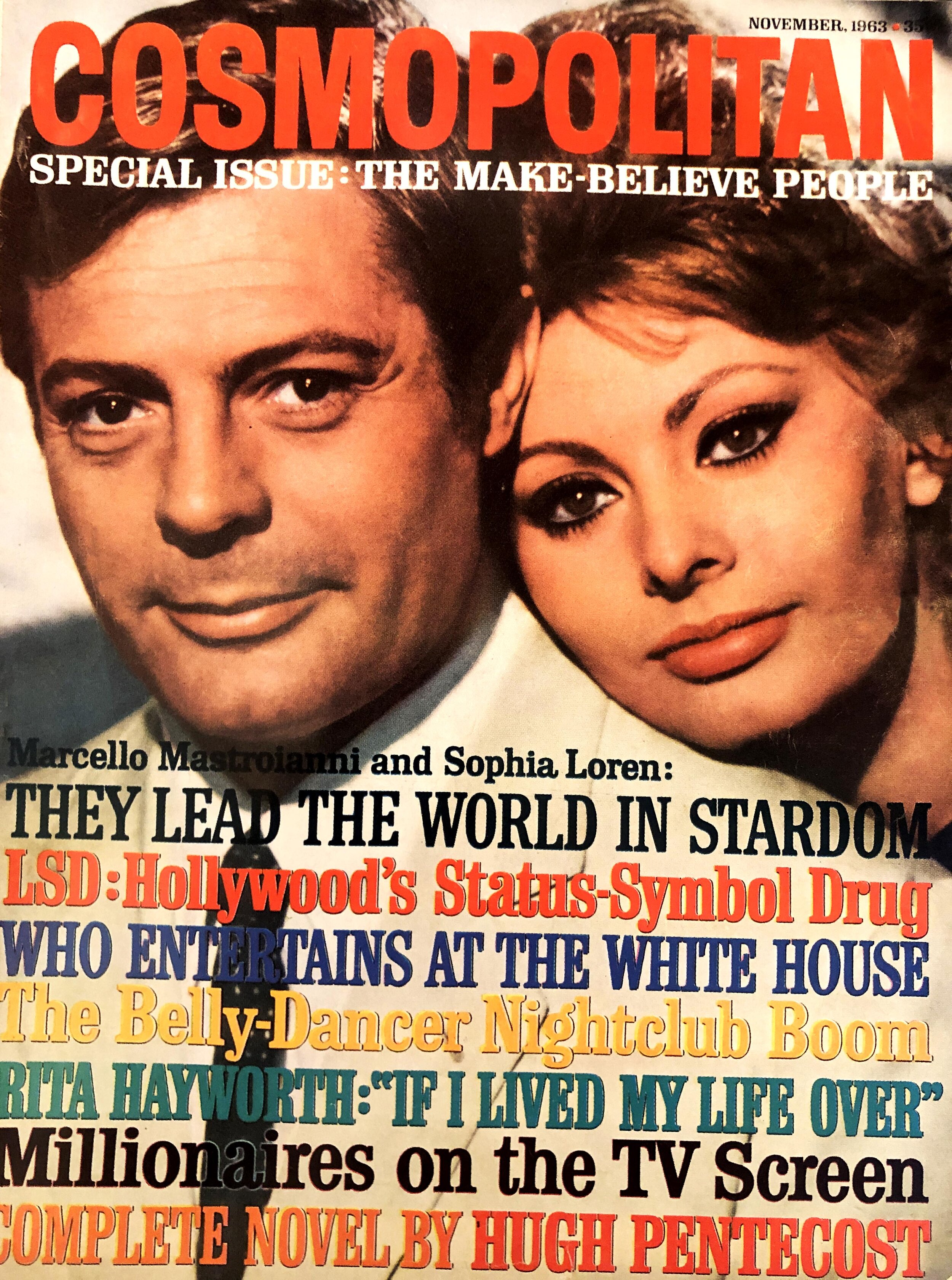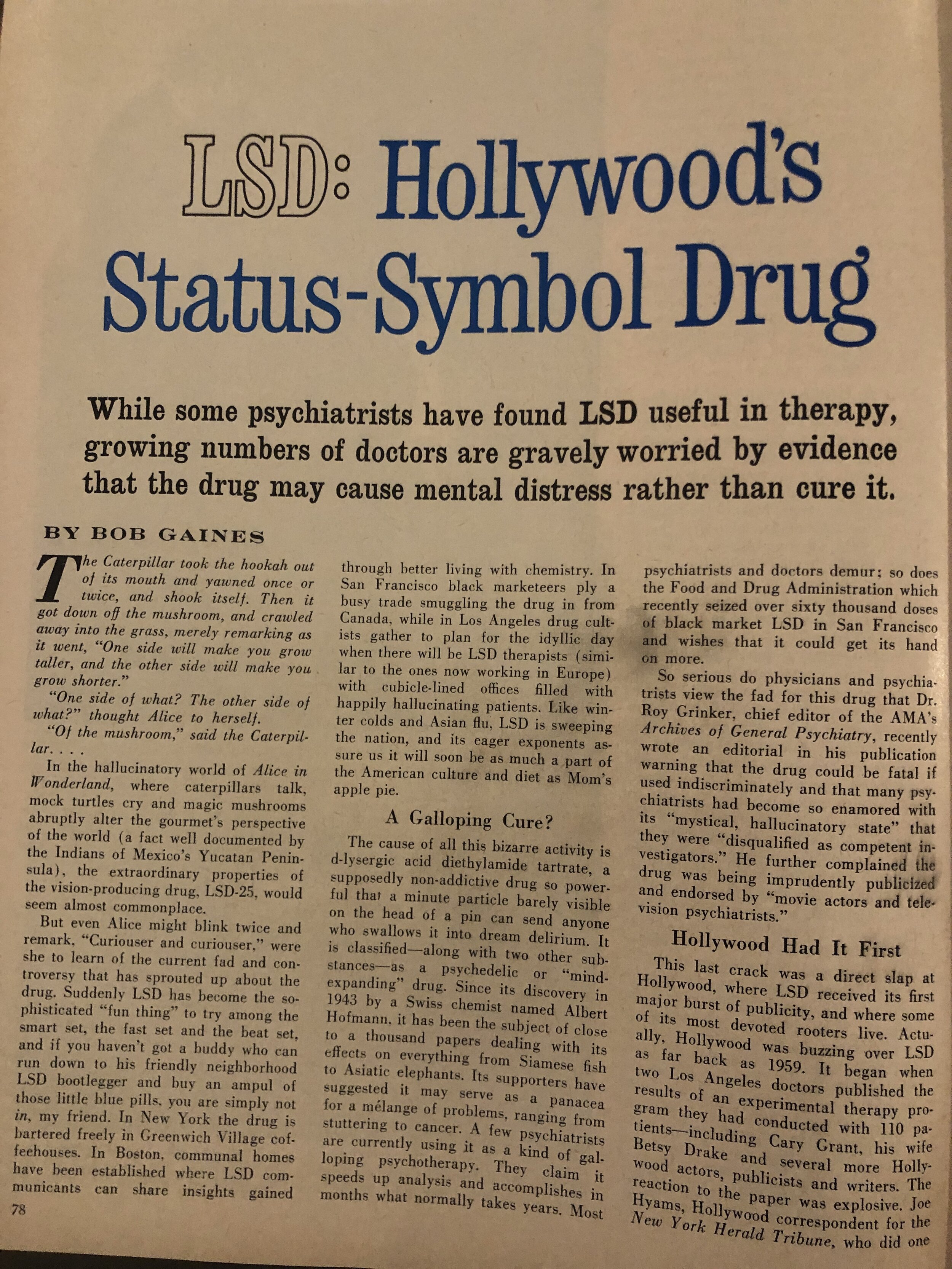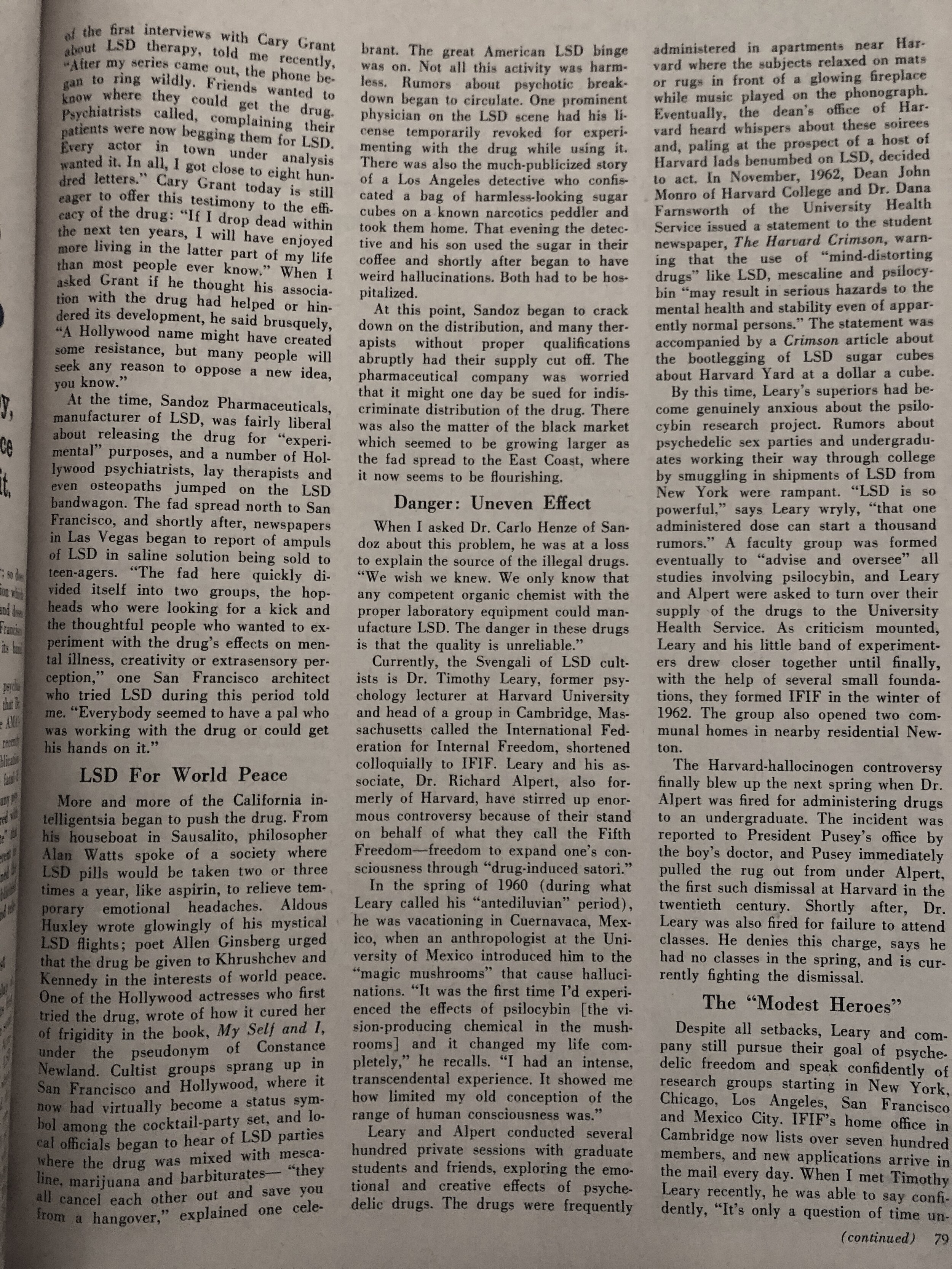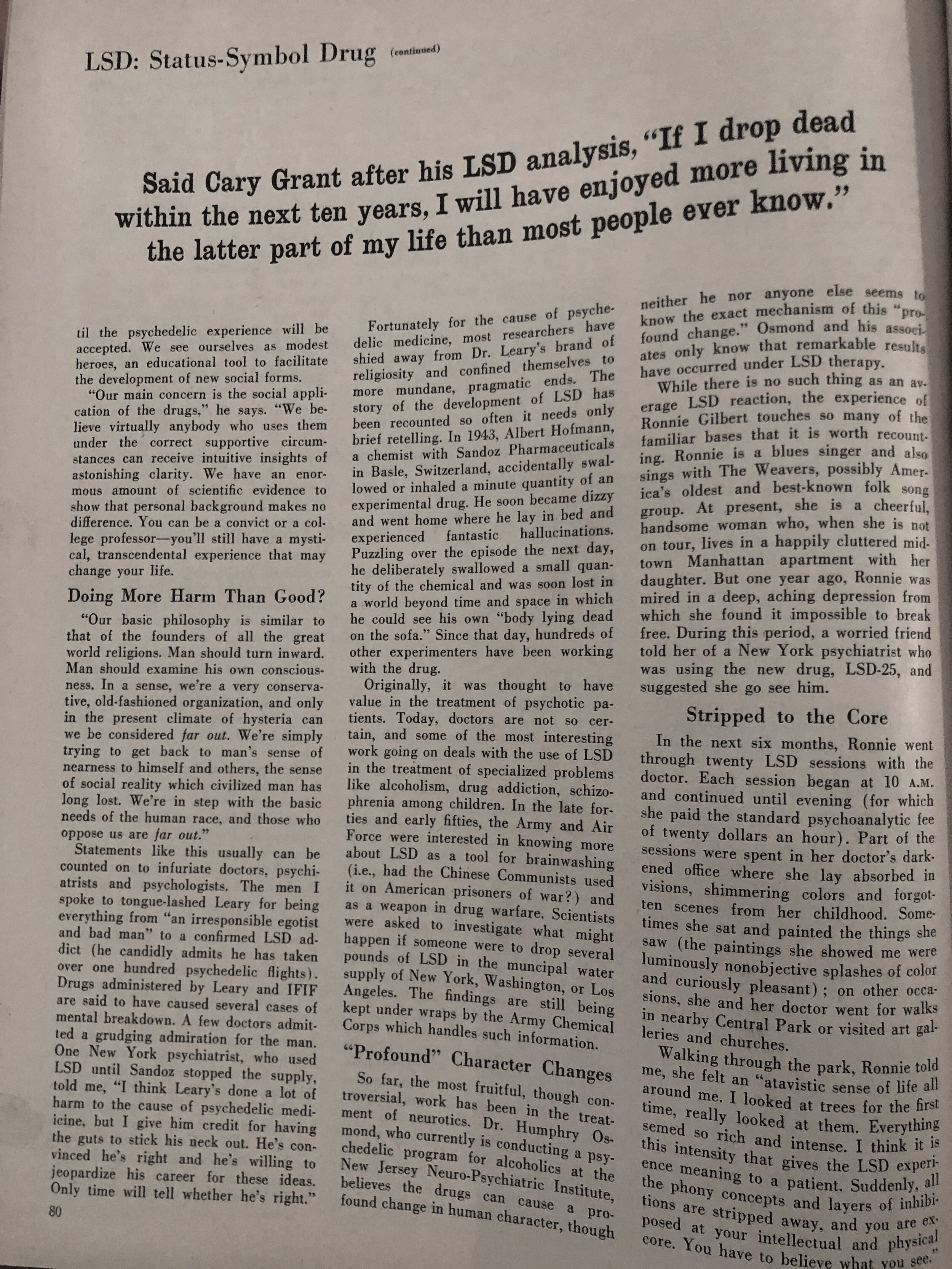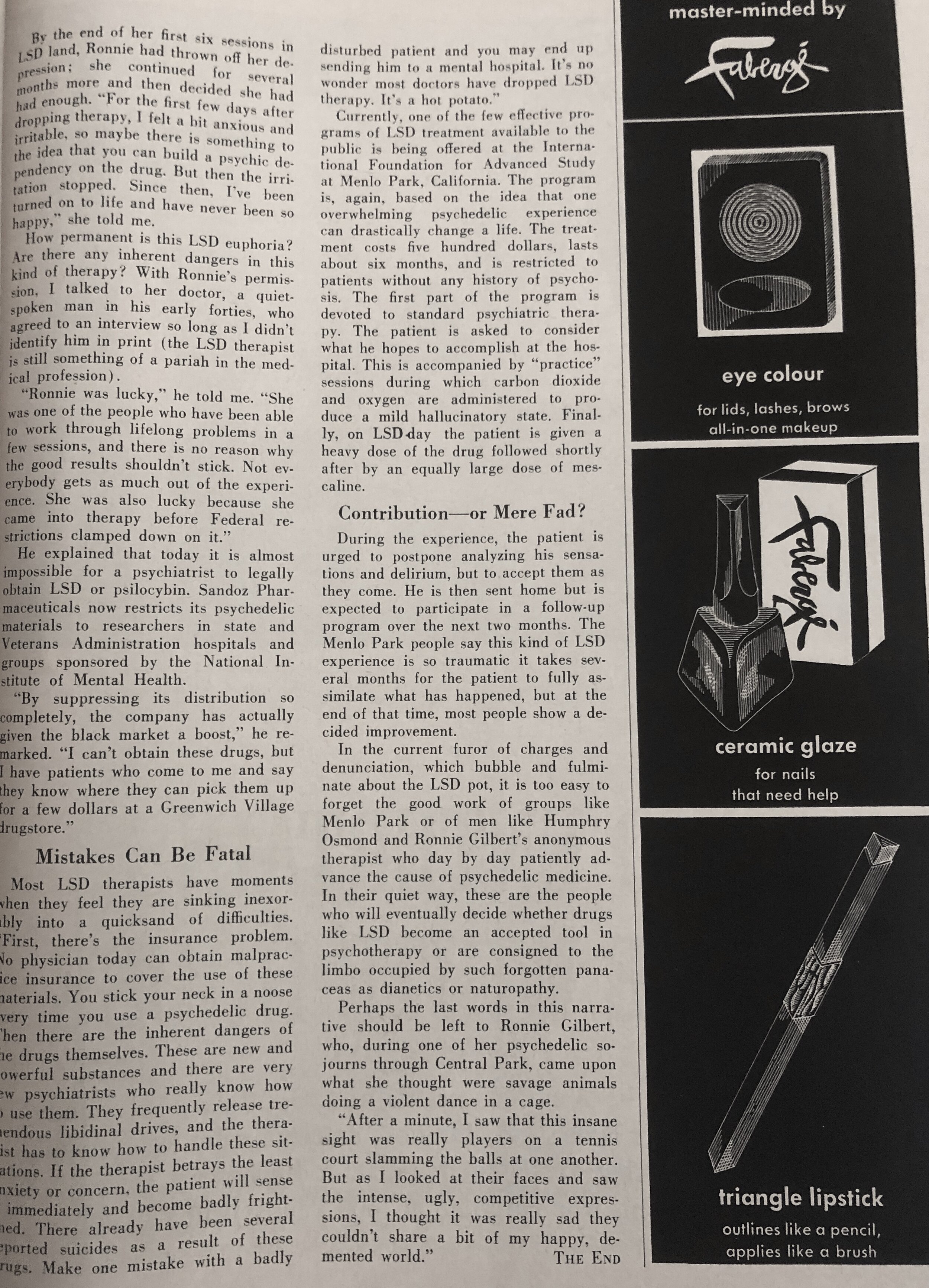LSD: Hollywood's Status-Symbol Drug | Cosmopolitan, November 1963
While some psychiatrists have found LSD useful in therapy, growing numbers of doctors are gravely worried by evidence that the drug may cause mental distress rather than cure it.
by Bob Gaines
The Caterpillar took the hookah out of its mouth and yawned once or twice, and shook itself. Then it got down off the mushroom, and crawled away into the grass, merely remarking as it went, “One side will make you grow taller, and the other side will make you grow shorter.”
“One side of what? The other side of what?” thought Alice to herself.
“Of the mushroom,” said the Caterpillar. . . .
In the hallucinatory world of Alice in Wonderland, where caterpillars talk, mock turtles cry and magic mushrooms abruptly alter the gourmet’s perspective of the world (a fact well documented by the Indians of Mexico’s Yucatan Peninsula), the extraordinary properties of the vision-producing drug, LSD-25, would seem almost commonplace.
But even Alice might blink twice and remark, “Curiouser and curiouser,” were she to learn of the current fad and controversy that has sprouted up about the drug. Suddenly LSD has become the sophisticated “fun thing to try among the smart set, the fast set and the beat set, and if you haven’t got a buddy who can run down to his friendly neighborhood LSD bootlegger and buy an apule of those little blue pills, you are simply not in, my friend. In New York the drug is bartered freely in Greenwich Village coffeehouses. In Boston, communal homes have been established where LSD communicates can share insights gained through better living with chemistry. In San Francisco black marketeers ply a busy trade smuggling the drug in from Canada, while in Los Angeles drug cultists gather to plan for the idyllic day when there wil be LSD therapists (similar to the ones now working in Europe) with cubicle-lined offices filled with happily hallucinating patients. Like winter colds and Asian flu, LSD is seeping the nation, and its eager exponents assure us it will soon be as much a part of the American culture and diet as Mom’s apple pie.
A Galloping Cure?
The cause of all this bizarre activity is d-lysergic acid diethylamide tartrate, a supposedly non-addictive drug so powerful that a minute particle barely visible on the head of a pin can send anyone who swallows it into dream delirium. It is classified-along with two other substances-a psychedelic or “mind-expanding” drug. Since its discovery in 1943 by a Swiss chemist named Albert Hofmann, it has been the subject of close to a thousand papers dealing with its effect on everything from Siamese fish to Asiatic elephants. Is supporters have suggested it may serve as a panacea for a melange of problems, ranging from stuttering to cancer. A few psychiatrists are currently using it as a kind of galloping psychotherapy. They claim it speeds up analysis and accomplishes in months what normally takes years. most physicists and doctors demur so does the Food and Drug Administration which recently seized over sixty thousand doses of black market LSD in San Francisco and wishes that it could get its hands on more.
So serious do physicians and psychiatrists view the fad for this drug that Dr. Roy Grinker, chief editor of the AMA’s Archives of General Psychiatry, recently wrote an editorial in his publication that the drug could be fatal if used indiscriminately and that many psychiatrists had become so enamored with its “mystical, hallucinatory state” that they were “disqualified as competent investigators.” He further complained the drug was being imprudently publicized and endorsed by “movie actors and television psychiatrists.”
Hollywood Had It First
The last crack was a direct slap at Hollywood, where LSD receive its first major burst of publicity, and where some of its most devoted rooters live. Actually, Hollywood was buzzing over LSD as far back as 1959. It began when two Los Angeles doctors published the results of an experimental therapy program they had conducted with 110 patients-including Cary Grant, his wife Betsy Drake and several more Hollywood actors, publicists and writers. The reaction to the paper was explosive. Joe Hyams, Hollywood correspondent for the New York Herald Tribune, who did one of the first interviews with Cary Grant about LSD therapy, told me recently, “After my series came out, the phone began to wring wildly. Friends wanted to know where they could get the drug. Psychiatrists called, complaining their patients were now begging them for LSD. Every actor in town under analysis wanted it. In all, I got close to eight hundred letters.” Cary Grant today is still eager to offer this testimony to the efficacy of the drug: “If I drop dead within the next ten years, I will have enjoyed more living in the latter part of my life than most people ever know.” When I asked Grant if he thought his association with the drug had helped or hindered its development, he said brusquely, “A Hollywood name might have created some resistance, but many people will seek any reason to oppose a new idea, you know.”
At the time, Sandoz Pharmaceuticals, manufacturer of LSD, was fairly liberal about releasing the drug for “experimental” purposes, and a number of Hollywood psychiatrists, lay therapists and even osteopaths jumped on the LSD bandwagon. The fad spread north to San Francisco, and shortly after, newspapers in Las Vegas began to report of ampuls of LSD in saline solution being sold to teen-agers.” “The fad here quickly divided itself into two groups, the hopheads who were looking for a kick and the thoughtful people who wanted to experiment with the drug’s effects on mental illness, creativity or extrasensory perception,” one San Francisco architect who tried LSD during this period told me. “Everybody seemed to have a pal who was working with the drug or could get his hands on it.”
LSD For World Peace
More and more of the California intelligentsia began to push the drug. From his houseboat in Sausalito, philosopher Alan Watts spoke of a society where LSD pills would be taken two or three times a year, like aspirin, to relieve temporary emotional headaches. Aldous Huxley wrote glowingly of his mystical SD flights; poet Allen Ginsberg urged that the drug be given to Khruschev and Kennedy in the interest of world peace. One of the Hollywood actresses who first tried the drug, who wrote of how it cured of frigidity in the book, My Self and I, under the pseudonym of Constance Newland Cultist groups sprang up in San Francisco and Hollywood, where it now had virtually become a status symbol among the cocktail-party set, and local officials began to hear of LSD parties where the drug was mixed with mescaline, marijuana and barbiturates - “they all cancel each other out and save you from a hangover,” explained one celebrant. The great American LSD binge was on. Not all this activity was harmless. Rumors about psychotic breakdown began to circulate. One prominent physician on the LSD scene had his license temporarily revoked for experiment with the drug while using it. There was also the much-publicized story of a Los Angeles detective who confiscated a bag of harmless-looking sugar cubes on a known narcotics peddler and took them home. That evening the detective and his son used the sugar in their coffee and shortly after began to have weird hallucinations. Both had to hospitalized.
At this point, Sandoz began to crack down on the distribution, and many therapists without proper qualifications abruptly had their supply cut off. The pharmaceutical company was worried that is might one day be sued for indiscriminate distribution of the drug. There was also the matter of the black market which seemed to be growing larger as the fad spread to the East Coast, where it now seems to be flourishing.
Danger: Uneven Effect
When I asked Dr. Carlo Henze of Sandoz about the problem, he was at a loss to explain the source of the illegal drugs. “We wish we knew. We only know that any competent organic chemist with the proper laboratory equipment could manufacture LSD. The danger in these drugs is that the quality is unreliable.
Currently, the Svengali of LSD cultists is Dr. Timothy Leary, former psychology lecturer at Harvard University and head of a group in Cambridge, Massachusetts called the International Federation of Internal Freedom, shortened colloquially to IFIF. Leary and his associate, Dr. Richard Alpert, also formerly of Harvard, having stirred up enormous controversy because of their stand on behalf of what they call the Fifth Freedom-freedom to expand one’s consciousness through “drug-induced satori.”
In the spring of 1960 (during what Leary called his “antediluvian” period), he was vacationing in Cuernavaca, Mexico, when an anthropologist at the University of Mexico introduced him to the “magic mushrooms” that cause hallucinations. “It was the first time I’d experienced the effects of psilocybin [the vision-producing chemical in the mushrooms] and it changed my life completely,” he recalls. “I had an intense transcendental experience. It showed me how limited my old conception of the range of human consciousness was.”
Leary and Alpert conducted several hundred private sessions with graduate students and friends, exploring the emotional and creative effects of psychedelic drugs. The drugs were frequently administered in apartments near Harvard where the subjects relaxed on mats or rugs in front of a glowing fireplace while music played on the phonograph. Eventually, the dean’s office of Harvard heard whispers about these soirees and, paling at the prospect of a host of Harvard lads benumbed on LSD, decided to act. In November, 1962, Dean John Monro of Harvard College and Dr. Dana Farnsworth of the University Health Service issued a statement to the student newspaper, The Harvard Crimson, warning that the use of “mind-distorting drugs” like LSD, mescaline and psilocybin “may result in serious hazards to the mental health and stability even of apparently normal persons.” The statement was accompanied by a Crimson article about the bootlegging of LSD sugar cubes about Harvard Yard at a dollar a cube.
By this time, Leary’s superiors had become genuinely anxious about the psilocybin research project. Rumors about psychedelic sex parties and undergraduates working their way through college by smuggling in shipments of LSD from New York were rampant. “LSD is so powerful” says Leary wryly, “that one administered dose can start a thousand rumors.” A faculty group was formed eventually to “advise and oversee” all studies involving psilocybin, and Leary and Alpert were asked to turn over their supply of the drugs to the University Health Service. As criticism mounted, Leary and his little band of experimenters drew closer together until finally, with the help of several small foundations, they formed IFIF in the winter of 1962. The group also opened two communal homes in nearby residential Newton.
The Harvard-hallucinogen controversy finally blew up the next spring when Dr. Alpert was fired for administering drugs to an undergraduate. The incident was reported to President Pusey’s office by the boy’s doctor, and Pusey immediately pulled the rug out from under Alpert, the first such dismissal at Harvard in the twentieth century. Shortly after, Dr. Leary was also fired for failure to attend classes. He denies this charge, say he had no classes in the spring, and is currently fighting the dismissal.
The “Modest Heroes”
“Said Cary Grant after his LSD analysis, “If I drop dead within the next ten years, I will have enjoyed more living in the latter part of my life than most people ever know.”
Despite all setbacks, Leary and company still pursue their goal of psychedelic freedom and speak confidently of research groups starting in New York, Chicago, Los Angeles, San Francisco and Mexico City. IFIF’s home office in Cambridge now lists over seven hundred members, and new applications arrive in the mail every day. When I met Timothy Leary recently, he was able to say confidently, “It's only a question of time until the psychedelic experience will be accepted. We see ourselves as modest heroes, an educational tool to facilitate the development of new social forms.
“Our main concern is the social application of the drugs,” he says. “We believe virtually anybody who used them under the correct supportive circumstances can receive intuitive insights of astonishing clarity. We have an enormous amount of scientfic evidence to show that personal background makes no difference. You can be a convict or a college professor-you’ll still have a mystical, transcendental experience that may change your life.
Doing More Harm Than Good?
“Our basic philosophy is similar to that of the founders of all the great world religions. Man should turn inward. Man should examine his own consciousness. In a sense, we’re a very conservative, old-fashioned organization, and only in the present climate of hysteria can we be considered far out. We’re simply trying to get back to man’s sense of nearness to himself and others, the sense of social nearness which civilized man has long lost. We’re in step with the basic needs of the human race, and those who oppose us are far out.”
Statements like this usually can be counted on to infuriate doctors, psychiatrists and psychologists. The men I spoke to tongue-lashed Leary for being everything from “an irresponsible egotist and bad man” to a confirmed LSD addict (he candidly admits he has taken over one hundred psychedelic flights.) Drugs administered by Leary and IFIF are said to have caused several cases of mental breakdown. A few doctors admitted a grudging admiration for the man. One new York psychiatrist, who used LSD until Sandoz stopped the supply, told me, “I think Leary’s done a lot of harm to the cause of psychedelic medicine, but I give him credit for having the guts to stick his neck out. He’s convinced he’s right and he’s willing to jeopardize his career for these ideas. Only time will tell whether he's right.
Fortunately for the cause of psychedelic medicine, most researchers have shied away from Dr. Leary’s brand of religiosity and confined themselves to more mundane, pragmatic ends. The story of the development of LSD has been recounted so often it needs only brief retelling. In 1943, Albert Hofmann, a chemist with Sandoz Pharmaceuticals in Basle, Switzerland, accidentally swallowed or inhaled a minute quality of an experimental drug. He soon became dizzy and went home where he lay in bed and experienced fantastic hallucinations. Puzzling over the episode the next day, he deliberately swallowed a small quantity of the chemical and was soon lost in a world beyond time and space in which he could see his own “body lying dead on the sofa.” Since that day, hundreds of other experimenters have been working with the drug.
Originally, it was thought to have value in the treatment of psychotic patients. Today, doctors are not so certain, and some of the most interesting work going on deals with the use of LSD in the treatment of specialized problems like alcoholism, drug addiction, schizophrenia among children. In the late forties and early fifties, the Army and Air Force were interested in known more about LSD as a tool for brainwashing (i.e., had the Chinese Communists used it on American prisoners of war?) and as a weapon in drug warfare. Scientists were asked to investigate what might happen if someone were to drop several pounds of LSD in the municipal water supply of New York, Washington, or Los Angeles. The findings are still being kept under wraps by the Army Chemical Corps which handles such information.
“Profound” Character Changes
So far, the most fruitful, though controversial, work has been in the treatment of neurotics. Dr. Humphry Osmond, who curently is conducting a psychedelic program for alcoholics at the New Jersey Neuro-Psychiatric Institute, believes the drugs can cause a profuon change in human character, though neither he nor anyone else seems to know the exact mechanism of this “profound change” Osmond and his associates only know that remarkable results have occurred under LSD Therapy.
While there is no such thing as an average LSD reaction, the experience of Ronnie Gilbert touches so many of the familiar bases that it is worth recounting. Ronnie is a blues singer and also sings with The Weavers, possibly America’s oldest and best-known folk song group. At present, she is a cheerful handsome woman who, when she is not on tour, lives in a happily cluttered midtown Manhattan apartment with her daughter. But one year ago, Ronnie was mired in a deep, aching depression from which she found it impossible to break free. During this period a worried friend told her of a New York psychiatrist who was using the new drug, LSD-25, and suggested she go see him.
Stripped to the Core
In the next six months, Ronnie went through twenty LSD sessions with the doctor. Each session began at 10 a.m. and continue until evening (for which she paid the standard psychoanalytic fee of twenty dollars an hour). Part of the sessions were spent in her doctor’s darkened office where she lay absorbed in visions, shimmering colors and forgotten scenes from her childhood. Sometimes she sat and painted the things she saw (the paintings she showed me were luminously nonobjective splashes of color and curiously pleasant); on other occasions, she and her doctor went for walks in nearby Central Park or visited art galleries and churches.
Walking through the park, Ronnie told me, she felt an “atavistic sense of life all around me. I looked at trees for the first time, really looked at them. Everything seemed so rich and intense. I think it is this intensity that gives the LSD experience meaning to a patient. Suddenly, all the phony concepts and layers of inhibitions are stripped away, and you are exposed at your intellectual and physical core. You have to believe what you see.”
By the end of her first six sessions in LSD land, Ronnie had thrown off her depression; she continued for several months more and then decided she had had enough. “For the first few days after dropping therapy, I felt a bit anxious and irritable, so maybe there is something to the idea that you can build a psychic dependency on the drug. But then the irritation stopped. Since then, I’ve been turned on to life and have never been so happy,” she told me.
How permanent is this LSD euphoria? Are there any inherent dangers in this kind of therapy? With Ronnie’s permission, I talked to her doctor, a quiet-spoken man in his early forties, who agreed to an interview so long as I didn’t identify him in print (the LSD therapist is still something of a pariah in the medical profession).
“Ronnie was lucky,” he told me. “She was one of the people who have been able to work through lifelong problems in a few sessions, and there is no reason why the good results shouldn’t stick. Not everybody gets as much out of the experience . She was also lucky because she came into therapy before Federal restrictions clamped down on it.”
He explained that today it is almost impossible for a psychiatrist to legally obtain LSD or psilocybin. Sandoz Pharmaceuticals now restricts its psychedelic materials to researchers in state and Veterans Administration hospitals and groups sponsored by the National Institute of Mental Health.
“By suppressing its distribution so completely, the company has actually given the black market a boost,” he remarked. “I can’t obtain thee drugs, but I have patients who come to me and say they know where they can pick them up for a few dollars at Greenwich Village drugstore.”
Mistakes Can Be Fatal
Most LSD therapists have moments when they feel they are sinking inexorably into a quicksand of difficulties. “First, there’s the insurance problem. No physician today can obtain malpractice insurance to cover the use of these material. You stick your neck in a noose every time you use a psychedelic dug. Then there are the inherent dangers of the drugs themselves. These are new and powerful substances and there are very few psychiatrists who really know how to use them. They frequently release tremendous libidinal drives, and the therapist has to know how to handle these situations. If the therapist betrays the least anxiety or concern, the patient will sense it immediately and become badly frightened. There already have been several reported suicides as a result of these drugs. make one mistake with a badly disturbed patient and you ma end up sending him to a mental hospital. It’s no wonder most doctors have dropped LSD therapy. It’s a hot potato.”
Currently, one of the few effective programs of LSD treatment available to the public is being offered at the International Foundation for Advanced Study at Menlo Park, California. The program is, again, based on the idea that one overwhelming psychedelic experience can drastically change a life. The treatment cost five hundred dollars, lasts about six months, and is restricted to patents without any history of psychosis. The first part of the program is devoted to standard psychiatric therapy. the patient is asked to consider what he hopes to accomplish at the hospital. this is accompanied by “practice” sessions during which carbon dioxide and oxygen are administered to produce a mild hallucinatory state. Finally, on LSD day the patient is given a heavy dose of the drugs followed by shorty after an equally large dose of mescaline.
Contribution - or Mere Fad?
During the experience, the patient is urged to postpone analyzing his sensations and delirium, but to accept them as they come. H is then sent home but is expected to anticipate in a follow-up program over the next two months. The Menlo Park people say this kind of lSD experience is so traumatic it takes several months for the patient to fully assimilate what has happened but at the end of that time, most people show a decided improvement.
In the current furor of charges and denunciations, which bubble and fulminate about the LSD pot, it is too easy to forget the good work of groups like Menlo Park or of men like Humphry Osmond and Ronnie Gilbert’s anonymous therapist who day by day patiently advance the cause of psychedelic medicine. In their quiet way, these are the people who will eventually decide whether drugs like LD become an accepted tool in psychotherapy or are consigned to the limbo occupied by such forgotten panaceas as dianetics or naturopathy.
Perhaps the last word in the narrative should be left to Ronnie Gilbert, who, during one of her psychedelic sojouns through Central Park, came upon what she thought were savage animals doing a violent dance in a cage.
“After a minute, I saw that this insane sight was really players on a tennis court slamming the balls at one another. But as I looked at their faces and saw the intense, ugly, competitive expressions, I thought it was really sad they couldn’t share a bit of my happy, demented world.”
THE END
